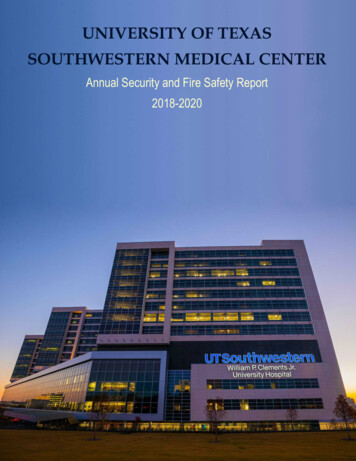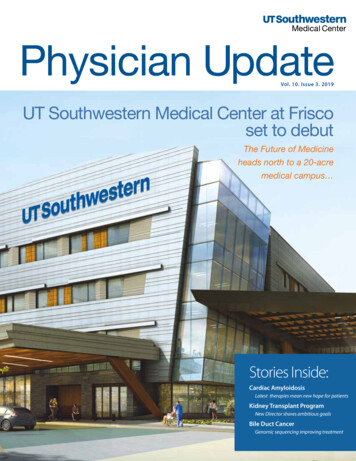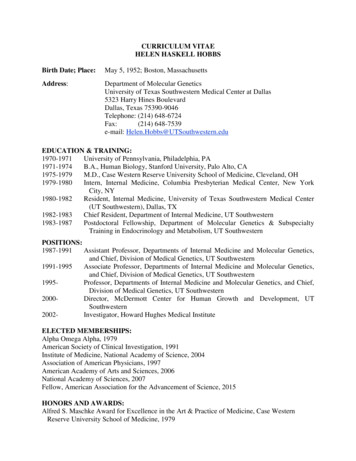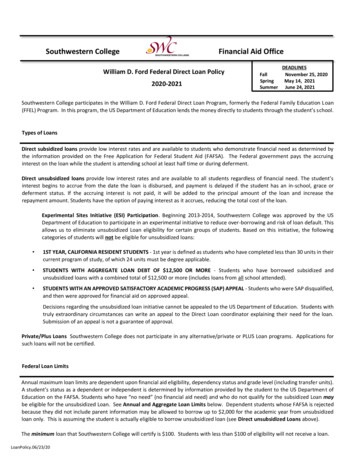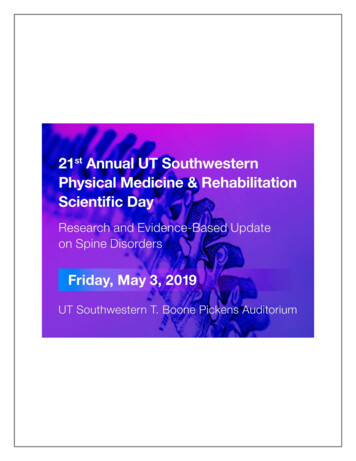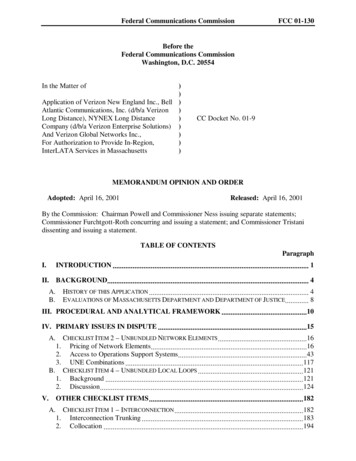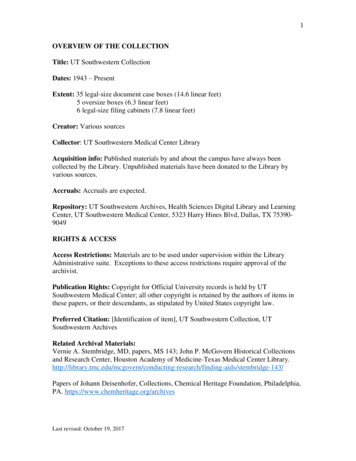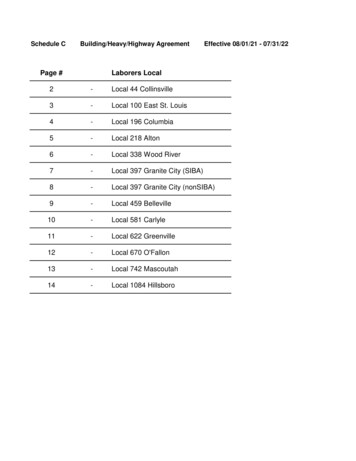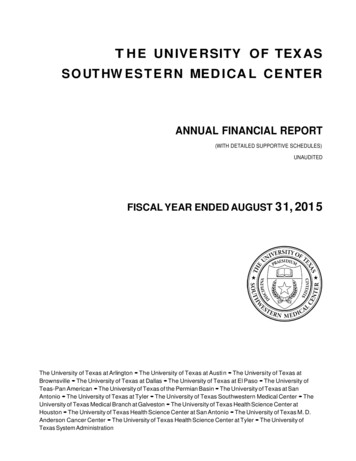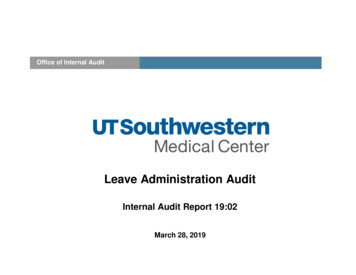
Transcription
Office of Internal AuditUT SouthwesternMedical CenterLeave Administration AuditInternal Audit Report 19:02March 28, 2019
ursouthwesternMedical CenterTable of ContentsI. Executive Summary 3BackgroundScope and ObjectivesConclusion355II. Detailed Observations and Action Plans MatrixIII. Appendices 817Appendix A – Risk Classifications and DefinitionsAppendix B – Leave Institutional Systematic ProcessingAppendix C – Leave Type Volume TrendingAppendix D – Leave Administration Average Response Time19:02 Leave Administration Audit17181920Page 2 of 20
ursouthwesternMedical CenterExecutive SummaryBackgroundUT Southwestern Medical Center (UT Southwestern) offers a comprehensive benefits package to eligible full-time, part-time and retiredemployees, including paid or unpaid leave time away from work, in accordance with applicable laws and policies. The Leave Administrationdivision of the Office of Human Resources administers the following types of leave:Family and MedicalLeave Act (FMLA)The FMLA is a Federal law that requires UT Southwestern to provide FMLA leave to eligible employees formedical, family, and military qualifying reasons. Employees are entitled to take up to 12 workweeks (26 forcertain military reasons) of job-protected, unpaid leave in any 12-month leave year. The FMLA also providesa right to reinstatement to the same or equivalent position and protects the employee from interference,discrimination, or retaliation.Catastrophic Sick Leave(CSL)The Catastrophic Sick Leave pool is based on state law and allows employees to donate sick leave into aninstitution-wide pool administered by Leave Administration. CSL is awarded based on established criteriato eligible employees who have exhausted all other available paid leave and the employee or immediatefamily member has a catastrophic illness or injury. Once awarded, CSL may be used in the same manneras regular sick leave.Parental LeaveParental Leave is based on state law and allows employees who are not eligible for FMLA to take up to 12work weeks of job-protected, unpaid leave for the birth or placement for adoption/foster care of a child within12 months.Military LeaveMilitary Leave is based on Uniformed Services Employment and Reemployment Rights Act of 1994(“USERRA”), as well as state law and UT System policy, regarding an employee’s right to take paid or unpaidleave to perform certain military service and right to reinstatement following extended unpaid military leave.Leave Without PayLeave Without Pay allows an employee to take unpaid leave under certain circumstances and withdepartment approval, as outlined in UT System and UT Southwestern policies. Approval of a period of leavewithout pay generally constitutes UTSW’s intent to return the employee to the same or a similar position atthe conclusion of the leave period.Sick Leave DonationsSick Leave Donation is based on state law and allows employees to donate the employee’s own sick leaveaccrued hours in any amount (up to the accrual balance) to another employee, if certain conditions are met.The Leave Administration division, reports to the Director, Employee Benefits & Retirement, Employee Assistance Program (EAP), LeaveAdministration & Wellness Programs. The Director reports to the Assistant Vice President, Compensation, Benefits and Human ResourceInformation Systems (HRIS) in the Office of Human Resources. Staffing consists of four full time positions and a supervisor who areresponsible for providing leave assistance and administration for approximately 17,000 UT Southwestern employees.19:02 Leave Administration AuditPage 3 of 20
ursouthwesternMedical CenterExecutive SummaryThe overall administration of the leave programs are dependent on both the staff in the Leave Administration division and on each operatingdepartment’s timekeeping and reporting processes across the institution for recording, tracking and providing documentation to meet therequirements for each type of leave.See Appendix B for a Leave Institutional Systematic Processing depiction, and Appendix C and D for leave trending and response times.There are four different systems, OnBase, PeopleSoft HCM, Oracle, and Kronos to support Leave Administration processes anddocumentation retention requirements. OnBase is an enterprise content management nce.Oracle, an internally developed tool to track and managekey Leave Administration data, and enter informationrelating to leave records.PeopleSoft HCM is the system used to verify eligibilitycriteria for employees requesting leave.Kronos is the institution’s time tracking system that thePayroll department manages separately. Time keepingactivities recorded in Kronos are transmitted to PeopleSoftHCM to update payroll and leave (i.e., vacation and sick)accruals.Leave Requests by TypeCalendar Year 2018CatastrophicSick Leave0.50%Parental Leave1.12%Sick LeaveDonations0.25%Non-Paid Leave0.18%FMLA Intermittent10.32%These systems are independent and do not interface or sharedata to promote efficient and effective monitoring.The chart on the right shows percentages of the types of leave(administered by Leave Administration) taken by employeesduring calendar year 2018.19:02 Leave Administration AuditFMLA87.63%Page 4 of 20
ursouthwesternMedical CenterExecutive SummaryScope and ObjectivesThis audit was a part of the Fiscal Year (FY) 2019 Institutional Internal Audit Plan and included review of Leave Administration processes andkey financial and operational activities for Family and Medical Leave Act (FMLA), Catastrophic Sick Leave (CSL), Parental Leave, Sick LeaveDonations (SLD) and Leave Without Pay leave types. The audit scope was calendar year 2018.The overall objectives were to assess compliance with key regulations and institutional policies and procedures that includes evaluating theeffectiveness and efficiency of operations and programs over the internal controls that ensure achievement of objectives, safeguarding ofassets, and accuracy of reporting. Specifically: Current policies and processes are readily available to all applicable personnel,Efficient and effective leave administration operations and processes are in place,Timely and complete communications between Leave Administration, employees, management and providers,Compliant processing and approval of leave activities in accordance with federal regulations and UT Southwestern policies based ontype of leave and employment status,Appropriate financial tracking and monitoring of employee benefits based on the type of leave approved, andAppropriate system user controls such as access, approval workflow, and segregation of dutiesWe conducted our audit according to guidelines set forth by the Institute of Internal Auditors’ International Standards for the ProfessionalPractice of Internal Auditing.ConclusionEffective leave administration activities are essential to supporting the needs of UT Southwestern employees and ensuring the institutioncomplies with laws and regulations. Institutional policies and processes are in place for administering UT Southwestern’s various leaveprograms and activities, however, institutional requirements do not clearly define timekeeper responsibilities to record time in Kronos for theemployee’s home department. As a result, reconciliation and monitoring processes and controls that ensure accurate time reporting andcompliance with leave policies are not currently in place. Due to the lack of oversight and monitoring of time reporting and leave administrationprocesses within the employee’s home department, there are increased risks for inaccurate leave reporting and noncompliance with policies.Based on limited system capabilities, the Leave Administration team has to manually track and monitor employee leave activities, increasingthe risk of missing, incomplete or inaccurate time reported. Inaccurate leave tracking can result in inaccurate employee payroll, inefficienciesin reliable leave monitoring and reporting and increased risk that employees take leave in excess of what has been approved.19:02 Leave Administration AuditPage 5 of 20
ursouthwesternMedical CenterExecutive SummaryLeave Administration leaders are in the process of reviewing and selecting a comprehensive system to better manage and automate leaveactivities and replace or augment the four existing systems, OnBase, Oracle, PeopleSoft HCM and Kronos. The new Leave Managementsystem will support Leave Administration’s goals to provide improved compliance monitoring, on-demand education for employees andleaders, and improved tracking of leave activities. This tool will largely eliminate manual processes, improve efficiency of leave requestprocessing, improve monitoring capabilities, allow automated notifications for employees and supervisors, and improve reporting capabilities.Included in the table below are the observations noted, along with the respective disposition of the observations within the Medical Centerinternal audit risk definition and classification process. See Appendix A for Risk Rating Classifications and Definitions.Priority (0)-High (0)Medium (3)Low (1)Total re were no priority issues identified in the audit. Key improvement opportunities are summarized below.n1. Improve Controls to Ensure Accurate Kronos Time Tracking – Employees’ home department processes and controls thatensure appropriate Kronos transactions for employees with approved FMLA or Parental Leave are not adequate, resulting in anincreased risk of non-compliance with laws and regulations.n2. Enhance Monitoring Processes and Controls to Ensure Timely FMLA Intermittent or Reduced Schedule TrackingCompliance – Leave Administration does not have monitoring or reporting processes in place to identify and follow up on missingmonthly intermittent FMLA leave tracking forms. Without monitoring controls and enforcement of procedures, employees can abuseFMLA intermittent leave and negatively impact department productivity.n 3. Enforce Policy for Return To Work Authorization Submissions – Instances occurred where employees have returned to workfrom approved FMLA leave for their own serious health condition without providing the required return to work authorization.Returning to work without submitting medical clearance increases risk to the employee and the institution if an employee is unableto perform duties safely.n 4. Establish and Implement Timelines for All Leave Types – Parental and Leave Without Pay requests do not have establishedtimeline expectations. Response times for review and approval of these leave types, that are not subject to federal regulations, areon average 18 days, and significantly higher than other leave types that have federal regulation response timeframes such as FMLA(e.g., 5 days). Without established response timelines, delays may negatively affect benefit decisions and may result in employeedissatisfaction.Additional details for key improvement opportunities and action plans can be found in the Detailed Observations and Action Plans Matrix(Matrix) section of this report.19:02 Leave Administration AuditPage 6 of 20
ursouthwesternMedical CenterExecutive SummaryWe would like to thank the Leave Administration department for the courtesies extended to us and for their cooperation during our audit.Sincerely,Valla F. Wilson, Associate Vice President for Internal Audit, Chief Audit Executive, Interim Chief Compliance & HIPAA Privacy OfficerAudit Team:Melinda Lokey, Director, Internal AuditRobin Irvin, Manager, Internal AuditAngeliki Marko, Supervisor, Internal AuditDelaunda McCown, Senior Auditorcc:Beth Aubry, Supervisor, Leave AdministrationArnim E. Dontes, Executive Vice President, Business AffairsKathryn Flores, Assistant Vice President and Chief Information Officer, University HospitalsDevona Gray, Director, Employee Benefits & Retirement & Wellness ProgramsTrissi Gray, Director, Health System Compliance, Office of ComplianceLeah A. Hurley, J.D., Vice President, Legal AffairsJodi Levy, Assistant Vice President, Administrative SystemsMarc Milstein, Vice President and Chief Information Officer, Information ResourcesHeather Mishra, Associate Vice President, Academic and Administrative Information ResourcesVinod Nair, Director, Revenue Cycle and Business SystemsAngela Sanchez Alonzo, Interim Director, PayrollErin Sine, J.D., Director/Managing Attorney, General Legal ServicesJulie Sirkin, Assistant Vice President, Compensation, Benefits and Human Resource Information Systems (HRIS)Thomas Spencer, Ph.D., Assistant Vice President, IR Operations and Compliance, Academic and Administrative InformationResources19:02 Leave Administration AuditPage 7 of 20
UT SouthwesternMedical CenterDetailed Observations and Action Plans MatrixInstitutional ObservationsObservations in this section are issues identified that are outside the direct controlfor the function under review19:02 Leave Administration AuditPage 8 of 20
UTSouthwesternMedical CenterDetailed Observations and Action Plans MatrixObservationIRecommendationRisk Rating: Medium n1. Improve Controls that Ensure AccurateKronos Time TrackingEmployee home department processes are notadequate and controls are not in place to ensureappropriate Kronos transactions are recorded foremployees with approved FMLA or ParentalLeave, resulting in an increased risk of inaccuraterecords and non-compliance with laws andregulations.Kronos leave time reporting data compared toLeave Administration records identified thefollowing: Inaccurate leave type categories wereselected in Kronos by the employee’s homedepartment timekeeper:o 194 employees have approved ParentalLeave coded in Kronos as FMLA.o 66 employees have approved FMLA Leavecoded in Kronos as Parental Leave.Kronos does not deduct accruals fromemployee VSL (Vacation & Sick Leave)available balances when using the FMLALeave and Parental Leave tracking codes:o This tracking is currently optional and forinformational purposes only.o Departmental timekeepers were nottrained or were unaware of the way toappropriately process Kronos transactions.1. Define departmental Kronostransaction processing requirementsand expected controls that ensureappropriate recording of leave timetransactions.2. Update training and provide refreshereducation to department managersand supervisors, including timekeeperspecific training, on responsibilities forcomplying with leave policies andFederal regulations. Additionally,communicate with leaders to reinforcethese responsibilities to theirdepartments.3. Continue with plan for designing andimplementing a robust leaveadministration system. Evaluatesystem features that strengtheninternal controls and meet LeaveAdministration administrative needs.Ensure that system data integrity andaccuracy complies with federal andstate requirements, and institutionalpolicies.19:02 Leave Administration AuditManagement ResponseManagement Action Plans:1. Evaluation of Kronos leave trackingfeatures is in process and will be used todevelop a project plan for enhancementof Kronos.2. A. We will develop a refresher trainingplan for supervisors and timekeepers.The Kronos training team will conductKronos training for timekeepers. Inaddition, Legal will reinforce duringleader training and the LeaveAdministration team will revise emailcommunications to managersmanaging employees on an approvedleave.B. Training will also be included in thenew Leave Administration systemproject plan.C. Payroll will update the Kronos Cornerintranet resources as necessary.D. Communicate with the leaders toreinforce these responsibilities withintheir department.3. It is imperative that we develop a plan forimplementing a robust leaveadministration system. Cross-functionalcollaboration (e.g., Payroll, InformationResources, Legal) will be included in thenew Leave Administration system projectplan.Page 9 of 20
UTSouthwesternMedical CenterDetailed Observations and Action Plans MatrixObservationIooSupervisors or employees did not validateKronos transactions for accuracy.Procedures for periodically reviewingemployee leave balances forreasonableness were not in place.Recommendation4. Determine quality assurancemonitoring plan and includedepartmental monitoring proceduresthat ensure departments comply withleave policies, provide accurate leavereporting, and process transactions inaccordance with approved leave.5. Implement reconciliation processesthat monitor Kronos leave tracking toleave amounts approved by LeaveAdministration (e.g., FMLA Leave andParental Leave).Management Response4. Kronos monitoring activities will beincluded in the new Leave Administrationsystem project plan.5. Reconciliation processes for monitoringKronos activities will be included in thenew Leave Administration system projectplan.Action Plan Owners:1. Interim Director, PayrollAssistant Vice President, Compensation,Benefits and Human ResourceInformation Systems (HRIS)2. Assistant Vice President, Compensation,Benefits and Human ResourceInformation Systems (HRIS)Assistant Vice President, IR Operationsand Compliance, Academic andAdministrative Information ResourcesInterim Director, Payroll3. Assistant Vice President, Compensation,Benefits and Human ResourceInformation Systems (HRIS)Assistant Vice President, IR Operationsand Compliance, Academic andAdministrative Information Resources19:02 Leave Administration AuditPage 10 of 20
UTSouthwesternMedical CenterDetailed Observations and Action Plans MatrixIObservationRecommendationManagement ResponseDirector/Managing Attorney, GeneralLegal ServicesInterim Director, Payroll4. Assistant Vice President, Compensation,Benefits and Human ResourceInformation Systems (HRIS)Interim Director, Payroll5. Assistant Vice President, Compensation,Benefits and Human ResourceInformation Systems (HRIS)Interim Director, PayrollTarget Completion Dates:1. Identify requirements – August 31, 2019Develop project plan – September 30,20192. a. May 31, 2019b. February 28, 2020, or concurrent withgo-livec. September 30, 20193. February 28, 2020, or concurrent with golive4. February 28, 2020, or concurrent with golive5. February 28, 2020, or concurrent with golive19:02 Leave Administration AuditPage 11 of 20
UT SouthwesternMedical CenterDetailed Observations and Action Plans MatrixLeave AdministrationObservations19:02 Leave Administration AuditPage 12 of 20
UT SouthwesternMedical CenterDetailed Observations and Action Plans MatrixObservationRecommendationManagement ResponseRisk Rating: Medium n2. Enhance Monitoring Processes and Controlsto Ensure Timely FMLA Intermittent orReduced Schedule Tracking ComplianceLeave Administration does not have monitoring orreporting processes in place to identify and followup on missing monthly intermittent or reducedschedule FMLA leave tracking forms. Withoutmonitoring controls and enforcement ofprocedures, employees can abuse FMLAintermittent leave and impact departmentproductivity.Once FMLA Intermittent or Reduced ScheduleLeave is granted for employees, departmentmanagers and employees have a sharedresponsibility to submit to Leave Administrationmonthly tracking forms to report the FMLA daysand hours used. When the hours used are notreported to Leave Administration, it is difficult toprovide an accurate calculation of hoursremaining for FMLA to managers or employees.Until the new, more robust leaveadministration system plannedimplementation is complete, the followingshort term solutions are necessary:1. Implement monitoring processes toconfirm receipt of FMLA MonthlyIntermittent or Reduced ScheduleLeave tracking forms and ensurefollow up process is in place fordepartments and employees who donot comply with monthly submissionrequirements. Ensure hours used areupdated to prevent excess usagebeyond what has been approved.2. Provide routine and consistentreporting of FMLA available andremaining leave balances tosupervisors and employees afterintermittent or reduced schedule leaveis used.Reminders are manually processed by the LeaveAdmin Specialist when the employee is nearingthe approved hours limit. Updates are provided toemployees and supervisors upon request and nomore frequently than once every 30 day period.Management Action Plans:1. In the interim before implementing a newsystem, we will develop a monitoring planand send reminders to departmentleaders and employees until we receivemonthly tracking forms.2. We will evaluate, determine, andimplement the most cost effective methodfor performing the appropriatenotifications once intermittent or reducedschedule leave has been used. Additionaltemporary resources may be needed.Action Plan Owners:Assistant Vice President, Compensation,Benefits and Human Resource InformationSystems (HRIS)Assistant Vice President, AdministrativeSystemsTarget Completion Dates:1. June 30, 2019, dependent on availabletechnical support within InformationResources2. June 30, 2019Monitoring opportunities are largely due to havingmanual processes, lack of an automated systemand limited staffing. Manual follow up trackingwould be more labor intensive.19:02 Leave Administration AuditPage 13 of 20
UT SouthwesternMedical CenterDetailed Observations and Action Plans MatrixIObservationRisk Rating: Medium n3. Enforce Policy for Return To WorkAuthorization SubmissionsInstances occurred where employees havereturned to work from approved FMLA leave fortheir own serious health condition withoutproviding the required return to workauthorization. Returning to work withoutsubmitting medical clearance increases risk to theemployee and the institution if an employee isunable to perform duties safely.The Family and Medical Leave Policy (EMP-256)requires employees and supervisors/managers toprovide both department manager and LeaveAdministration an anticipated return to work date.The “Supervisors Guide to Managing FMLA”includes a requirement to provide LeaveAdministration with authorizations from a medicalprovider that allows employees to return to workafter taking leave for their own serious healthcondition.Monitoring and follow up is not in place andsystem controls are not available to notify LeaveAdministration when approved time is near theend of the period to ensure appropriatedocumentation is obtained when employeesreturn to work after taking leave for their ownserious health condition. Often times, employeesreturn to work early without notifying LeaveAdministration and departments do not require arelease from the medical provider authorizingearly return.Recommendation1. Revise communication to supervisorsto include clear responsibility that thedepartment needs to monitor andensure a return to work authorization isreceived from all employees returningfrom a block of FMLA leave for theirown serious health condition.2. During the design phase of the newsystem, establish the appropriatecommunication method for requestingreturn to work authorizations andnotifications to Leave Administration.3. Update training to timekeepers,supervisors, and managers to includeLeave Administration requirements fordepartments and employees.Management ResponseManagement Action Plans:1. We will program automated notices thatgo out to employees and supervisors.2. We will send communications todepartments as a reminder of theprocedures to follow prior to the return towork date and clearly state departmentsshould not allow employees to return untilthey follow the proper process.3. We will include the HR Essentials trainingprogram in Taleo course assignments forall leaders.Action Plan Owners:1 - 3. Assistant Vice President,Compensation, Benefits and HumanResource Information Systems (HRIS)3. Assistant Vice President, IR Operationsand Compliance, Academic andAdministrative Information ResourcesTarget Completion Dates:1. June 30, 2019, dependent on availabletechnical support within InformationResources2. June 30, 20193. June 30, 201919:02 Leave Administration AuditPage 14 of 20
UT SouthwesternMedical CenterDetailed Observations and Action Plans MatrixIObservationRecommendationRisk Rating: Low n4. Establish and Implement Timelines for AllLeave TypesParental and Leave Without Pay requests do nothave established timeline expectations. Responsetimes for review and approval of these leavetypes, that are not subject to federal regulations,are on average 18 days, and significantly higherthan other leave types that have federal regulationresponse timeframes such as FMLA (e.g., 5days).Although Parental and Leave Without Payaccounts for 1% of the Leave types, withoutestablished response timelines delays maynegatively affect benefit decisions and may resultin employee dissatisfaction.Management ResponseManagement Action Plans:1. Establish formal timelines andimplement response metrics for allleave types.1. We will define formal response timelinesfor Parental Leave and Leave WithoutPay.2. Update policies including departmentrequirements for established timelines.2. In the policy re-write, defined responsetimelines will be included.3. Develop monitoring processes toensure Leave Administration isresponding timely to leave requests inaccordance with established timelinesand in compliance with departmentpolicy.3. Utilizing information tracked in Oracle andOnBase, provide periodic reporting ofactual response time to defined timelines.Within the new Leave Administrationsystem, procedures to monitor responsetimeliness will be established andimplemented.Action Plan Owners:1. Assistant Vice President, Compensation,Benefits and Human ResourceInformation Systems (HRIS)2. Assistant Vice President, Compensation,Benefits and Human ResourceInformation Systems (HRIS)Director/Managing Attorney, GeneralLegal Services3. Assistant Vice President, AdministrativeSystems19:02 Leave Administration AuditPage 15 of 20
UT SouthwesternMedical CenterDetailed Observations and Action Plans MatrixIObservationRecommendationManagement ResponseTarget Completion Dates:1. Completed2. April 30, 20193. April 30, 2019, dependent on availabletechnical support within InformationResources19:02 Leave Administration AuditPage 16 of 20
UT SouthwesternMedical CenterAppendix A – Risk Classifications and DefinitionsAs you review each observation within the Detailed Observations and Action Plans Matrix of this report, please note that we have included a colorcoded depiction as to the perceived degree of risk represented by each of the observations identified during our review. The following chart isintended to provide information with respect to the applicable definitions and terms utilized as part of our risk ranking process:Degree of Risk and Priority of ActionRisk Definition- Thedegree of risk that existsbased upon the identifieddeficiency combined withthe subsequent priority ofaction to be undertaken bymanagement.PriorityAn issue identified by Internal Audit that, if not addressed immediately, has a highprobability to directly impact achievement of a strategic or important operationalobjective of a UT institution or the UT System as a whole.HighA finding identified by Internal Audit that is considered to have a high probabilityof adverse effects to the UT institution either as a whole or to a significantcollege/school/unit level. As such, immediate action is required by managementin order to address the noted concern and reduce risks to the organization.MediumA finding identified by Internal Audit that is considered to have a mediumprobability of adverse effects to the UT institution either as a whole or to acollege/school/unit level. As such, action is needed by management in order toaddress the noted concern and reduce the risk to a more desirable level.LowA finding identified by Internal Audit that is considered to have minimal probabilityof adverse effects to the UT institution either as a whole or to a college/school/unitlevel. As such, action should be taken by management to address the notedconcern and reduce risks to the organization.It is important to note that considerable professional judgment is required in determining the overall ratings presented on the subsequentpages of this report. Accordingly, others could evaluate the results differently and draw different conclusions. It is also important to note thatthis report provides management with information about the condition of risks and internal controls at one point in time. Future changes inenvironmental factors and actions by personnel may significantly and adversely impact these risks and controls in ways that this report didnot and cannot anticipate.19:02 Leave Administration AuditPage 17 of 20
ursouthwesternMedical CenterAppendix B – Leave Institutional Systematic ProcessingThe following diagram depicts the systematic processing tools utilized for employee leave.Leave Tracking System- Developed to track and manage keyLeave Administration data relating toleave recordsHR Module System- Utilized to verify the eligibility criteriafor employees requesting leavetEnterprise Content ManagementSystemWorkforce Management System- Utilized to manage Leavedocumentation and track sent andreceived correspondence- Time keeping activities are recordedin Kronos and transmitted toPeopleSoft HCM to update payroll andleave accruals19:02 Leave Administration AuditPage 18 of 20
ursouthwesternMedical CenterAppendix C – Leave Type Volume TrendingLeave type volume trending from January 2018 through January 2019 indicates continued growth in the number of leave requests thatare processed and managed each month by the Leave Administration team.Leave Type Volume TrendingCalendar Year 2018 through January 2019300025002000150010005000-January 2018February2018March 2018April 2018 Catastrophic Sick leave FMLAMay 2018June 2018 FMLA IntermittentJuly 2018--I-August 2018 September October 2018 November20182018 NON-PAID LEAVE PARENTAL LEAVE19:02 Leave Administration Audit-December January 20192018 SICK LEAVE DONATIONSPage 19 of 20
ursouthwesternMedic
Family and Medical Leave Act (FMLA) The FMLA is a Federal law that requires UT Southwestern to provide FMLA leave to eligible employees for medical, family, and military qualifying reasons. Employees are entitled to take up to 12 workweeks (26 for certain military reasons) of job-protected, unpaid leave in any 12-month leave year. The FMLA also .
